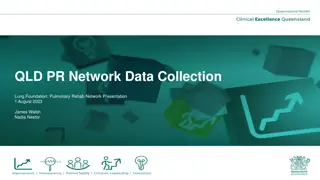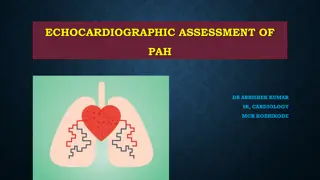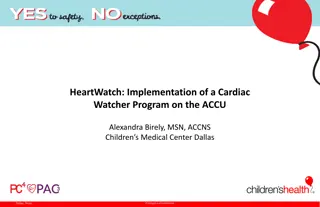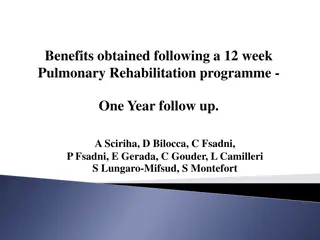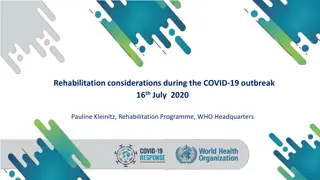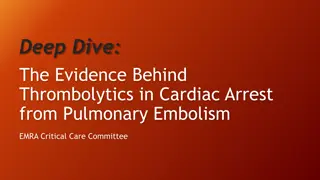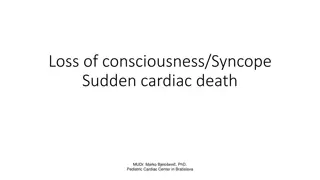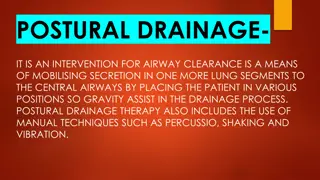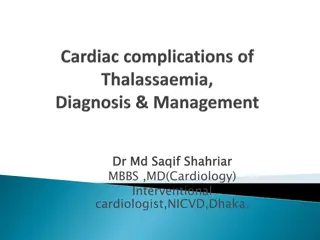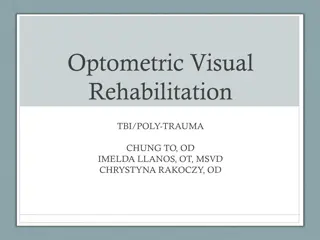Comprehensive Approach to Treatment Planning in Cardiac and Pulmonary Rehabilitation
The duties of an Individualized Treatment Plan (ITP) in cardiac and pulmonary rehabilitation encompass a holistic approach involving exercise, nutrition, psychosocial aspects, and individualized components specific to each patient. Compliance with CMS Conditions of Coverage and a thorough understanding of program components are crucial for successful outcomes. Additionally, programs must consider variations in enforcement across regions and seek clarification from relevant authorities to ensure adherence to regulations.
Download Presentation

Please find below an Image/Link to download the presentation.
The content on the website is provided AS IS for your information and personal use only. It may not be sold, licensed, or shared on other websites without obtaining consent from the author. Download presentation by click this link. If you encounter any issues during the download, it is possible that the publisher has removed the file from their server.
E N D
Presentation Transcript
ITP Treating the Treatment Plan Gayla Oakley RN, CCRP, MAACVPR Dir. Cardiology Services and Prevention Boone County Health Center Albion, Nebraska
o Why How This Photo by Unknown Author is licensed under CC BY
Duties of the ITP The ITP tells the patient s story. The ITP is comprehensive, multidisciplinary, including the patient input, document. The initial assessment and plan set the stage for successful treatment and meaningful outcomes. It must address the areas of exercise, nutrition, psychosocial and other core components/risk factors specific to the individual patient.
Why CMS This Photo by Unknown Author is licensed under CC BY
. CMS Conditions of Coverage Code of Federal Regulations 42 CFR 410.47 (Pulmonary) 410.49 (Cardiac)
Components of a Pulmonary Rehabilitation (PR) program: Physician-prescribed exercise each day Education and Training tailored to individual's needs -documented with signature, date and how it was addressed Psychosocial assessment - Does not need to be performed by a psychologist or psychiatrist. Validated tool or method of assessment, documented with signature, date with interpretation of the results Outcomes assessment- Did interventions/services result in benefit to the patient? An Individualized Treatment Plan detailing how the above components are utilized for each patient. The individualized treatment plan must be established, reviewed and signed by the Medical Director every 30 days Components of a Cardiac (CR) and Intensive Cardiac (ICR) rehabilitation program: Physician-prescribed exercise each day of cardiac rehabilitation Cardiac risk factor modification - including education, counseling, and behavioral intervention, tailored to the patients' individual needs (Note: Other Core Components/Risk Factors section of the ITP) Psychosocial assessment an evaluation of an individual s mental and emotional functioning as it relates to the individual s rehabilitation Outcomes assessment from the start and conclusion of CR/ICR, based on patient- centered outcomes; including exercise performance and self-reported measures of exertion and behavior An individualized treatment plan detailing how components are utilized for each patient. The individualized treatment plan must be established, reviewed, and signed by a physician (MD or DO) every 30 days.
Exception to The Rules Because each MAC across the country enforces this regulation differently, it is left up to the individual programs to contact their MAC or AACVPR Reimbursement Chair to learn how your MAC interprets these regulations for your facility/location.
Why CMS This Photo by Unknown Author is licensed under CC BY
AACVPR Program Certification The AACVPR Cardiac and Pulmonary Rehabilitation Program certification process is the only peer-review accreditation process designed to review individual facilities for adherence to standards and guidelines developed and published by AACVPR and other professional societies.
Out of the 600+ programs submitted in 2018, 254 of those were denied but eligible for remediation because of problems with the ITP. This Photo by Unknown Author is licensed under CC BY-SA
Top Reasons For Denial Missing elements/steps No evidence of progress toward goal HIPPAA violations MD signatures and dates greater than 30 days Clear labeling
All of these are avoidable This Photo by Unknown Author is licensed under CC BY-NC-ND
Individual Treatment Plan Core Elements: Four Required Steps: 1. Exercise 2. Nutrition 3. Psychosocial 4. Other Core Components/Risk Factors as applicable to individual patient 5.Oxygen use and titration (required for Pulmonary Rehab application) 1.Assessment 2.Plan: Includes Goals/Interventions and Education including initial exercise prescription 3. Reassessment: At least one 4. Discharge Plan
Other Core Components Other Cardiac Core Components/Risk Factors may include items such as: Hypertension - Cardiac Diabetes Weight Management Lipids Co-Morbidities Other Pulmonary Core Components/ Risk Factors may include items such as: Tobacco Use - Cardiac Environmental Issues History of Exacerbations Medication Adherence
ITP Components Initial Assessment Starting point Gather information/behaviors to change and determine outcomes to measure Need all the data before you can make the Plan Need an assessment for exercise, nutrition, psychosocial, oxygen and other core components/ risk factors that are important to THIS individual patient Example: (Exercise) 6 minute walk test
ITP Components Plan What are the Goals? Patient-centered What Interventions (Actions) are necessary to accomplish the goals established for the patient? Example: Exercise Prescription Education to assist patient with self-management Reasonable expectations Specific, measurable and relevant Individualize, keep in mind contraindications, individual abilities, limitations
ITP Components Re-Assessment An opportunity to determine if your patient is achieving the goals stated during the initial assessment Depending on their progress toward those goals, what comes next? Reassess the PLAN , Set new goals for the next 30 days, Proceed as planned It is hard to do a reassessment with minimal information Gather information, assess behaviors and set meaningful patient-centered goals Example: Repeat 6-minute walk test
ITP Components Discharge Plan Was everything accomplished? Where to go from here? Keeping on track, what else might be helpful? How is the ITP reviewed or revised? Pose the next clinical question Constantly evolving Example: the goal to be able to walk 30 minutes without stopping was not met ..now what? Continue with maintenance rehab program, update ExRx, encourage membership to gym, establish new long-term goals
Cardiac and Pulmonary Certification Application Requirements HIPAA compliant A single comprehensive document Must be completed in the data collection period Must be for an actual patient that has completed all required elements and steps. Must have a complete initial assessment, at least one reassessment and a discharge plan Must have the assessment and reassessment data/statements on the ITP Reassessments should include progress toward goal information Must include at least one ACTIVE core component For Pulmonary Rehab, ITP must be submitted for a patient
Tips For Success This Photo by Unknown Author is licensed under CC BY
HIPPA Compliant HIPAA violations are an automatic denial of the page Have at least two people look at any uploaded documents to ensure no violations Common HIPAA; Name, date of birth, telephone numbers, fax numbers, electronic email addresses, social security number, medical record number, health plan beneficiary numbers, account numbers
Missing Steps/Elements No active core components Pulmonary patient not on oxygen Initial exercise prescription on the ITP No reassessment
Evidence of progress toward goal Make sure you provide details about progress tell the story! An opportunity to determine if your patient is achieving the goals stated during the initial assessment Reassess the plan, set new goals for the next 30 days Data or scores at reassessment are required It is hard to do a reassessment with minimal information Lack of detail with progress toward goal check off boxes, no dates, no data
MD signatures and dates greater than 30 days Physician signatures and dates outside of 30 day rule New application platform Establish a schedule of when the ITP s are signed (Day 21 each month) Have a monthly program update meeting with MD Electronic signature and date ideal but does it work for everyone Pulmonary face to face
Clear labeling Lack of clear labeling of the elements and steps.. help the reviewers find what you want them to see. Highlight it, circle it, put flashing lights on it . Print off the ITP checklist Make labels or write elements and steps on the ITP
Double check, double check, double check http://cdn2.hubspot.net/hub/178693/file-390535718-jpg/images/avoiding-pitfalls-resized-600.jpg Poor quality documents uploaded. Missing documents. The wrong requirements. Correct data collection period. Review and copy the application. For pulmonary rehab, the ITP submitted has to be on oxygen. Must have one active core component. Show your finest.
Template AACVPR does not endorse any ITP or ITP format published by telemetry or electronic medical record companies. Stuck in our old ways . We have been using the same documentation forever. Old forms that don t meet the needs of today and do you need them. Network with others in your state/region.
Template--Facility Specific Make it work for you and use it. ITP is only as good as the people that use it This Photo by Unknown Author is licensed under CC BY-NC-ND
Template--EMR EMR all different, even within the same EMR s are difficult to find elements. Some ITP are long up to 40 pages. Critical labeling. Talk to your EMR vendor
Templatemonitor co. Monitoring company can be customized Many different features Reach out to other programs Bridge to EMR
Why CMS This Photo by Unknown Author is licensed under CC BY
Good Patient Care Patient s rehab story from initial assessment to discharge. Individualized plan. Discharge include assessment of goals met and next steps. Well designed Makes job easier Allow better patient management Better individual and program outcomes.
2018 Performance Measures CARDIAC Performance Measures Optimal Blood Pressure Control at Completion of Cardiac Rehab Improvement in Functional Capacity at Completion of Cardiac Rehab Improvement in Depression at Completion of Cardiac Rehab Tobacco Use Intervention Performance Measure for Cardiac Rehabilitation PULMONARY Performance Measures Improvement in Functional Capacity at Completion of Pulmonary Rehab Improvement in Dyspnea at Completion of Pulmonary Rehab Improvement in Health-Related Quality of Life at Completion of Pulmonary Rehab
Stay Up-To-Date Annual report Web-casts AACVPR web site News and Views Affiliate Meetings AACVPR Annual Meeting
Case Example This Photo by Unknown Author is licensed under CC BY-NC-ND
Ask the Questions.. Find the Answers Is your ITP a chore to fill out? Are you doing double and triple documentation? Is your ITP a functional tool? Is your patient involved in the monthly review? Are you measuring meaningful information allowing effective outcomes? Does your ITP and how it s utilized in your program need some help? Quality Improvement Process!
Goakley@boonecohealth.org This Photo by Unknown Author is licensed under CC BY-SA-NC





